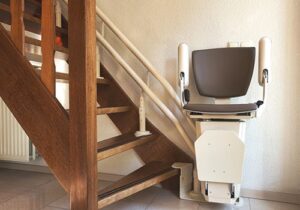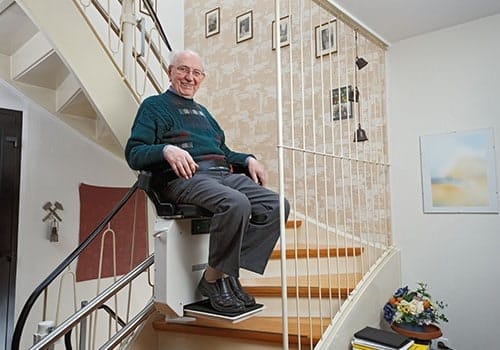Many seniors have mobility issues, which can be problematic when living in a home with stairs. As such, many seniors explore having a stair lift installed in their homes.
These devices can be expensive, so insurance coverage could greatly help people who need to install a stair lift.
If you are a Medicare beneficiary, you might wonder whether your Medicare coverage will help pay for a stair lift. Keep reading as we give you all the details about Medicare coverage of stair lifts for seniors, plus some other ways to get help paying for one.
Does Medicare Cover Stair Lifts?
Does Medicare cover stair lifts? The short answer is no. Medicare does not cover the cost of stair lifts. You probably already knew that Medicare Part A does not cover this cost since your Part A coverage is hospital insurance.
However, many people believe that Medicare Part B might cover stair lifts. Part B of Medicare covers durable medical equipment (DME) but does not classify a stair lift as DME. Instead, it is considered as a modification to the home.
Medicare covers mobility devices such as wheelchairs, canes, scooters, walkers, hospital beds, crutches, and others. In minimal circumstances, Medicare might cover a small portion of the cost of a stair lift if the lift has a seat that moves up and down to allow the individual to get in and out of the chair more easily.
However, this type of seat is a premium feature, and the extra cost of this feature would usually be more than the Medicare reimbursement.
You should also know that Medicare supplemental insurance (Medigap plans) does not pay for stair lifts either. Medigap plans help cover out-of-pocket expenses associated with Medicare coverage, like deductibles and copays. Since Medicare does not cover stair lifts, Medigap will not cover these devices either.
KEY TAKEAWAYS
- Original Medicare does not cover stair lifts; they are not considered durable medical equipment (DME) under Medicare Part B, but rather modifications to a home.
- The average stair lift cost is over $7,500 and can cost over $20,000 for more complicated installations.
- There are other government programs and insurance options available that may be able to assist with the cost of the stair lift.
Average Cost Of Stair Lifts

The average cost of a stair lift is about $7,500. Given this cost, you can quickly see why having insurance coverage for this device would be helpful. Stair lifts can range from just over $2,200 to nearly $20,000. Several factors affect the total cost.
- First, the height and configuration of your home’s stairs have a significant effect on the cost of the lift. The more stairs you have, the higher the cost is likely to be.
- Also, if your stairs are too narrow or if you have a curved staircase, the lift is likely to be more expensive. The installation will be more demanding on narrow steps, increasing the cost.
- The price of the lift is also affected by the number of features included in it. A simple plastic chair attached to the lift usually costs less. However, chairs that raise and lower to make getting into and out of the lift easier will cost more.
- Your location can also affect the lift’s cost, as the labor to install the product is more expensive in some areas than others.
If you are considering a stair lift, you should find someone in your area who sells and installs the devices. They can provide you with a more exact quote of the total cost to install one in your home.
Must read articles related to Medicare
Other Coverage Options For A Stair Lift
Now that you know Original Medicare does not cover stair lifts, you might wonder what other coverage options are available. Here are some other options that you might be able to take advantage of to help cover the cost of a stair lift.
-
Medicare Advantage Plans
Medicare Part C plans combine your Part A and Part B coverage into a single plan that is easier to manage. Medicare Advantage plans are managed by private insurance companies that contract with Medicare. These plans must provide the same minimum level of coverage as Original Medicare, but many of the plans provide additional benefits beyond traditional Medicare coverage.
Some Medicare Advantage plans provide coverage for stair lifts and chair lifts. You would need to check your specific plan for coverage details. If you want to find a Medicare Advantage plan that provides this coverage, you should check the Medicare plan finder tool. You can quickly and easily compare the plans that are available in your area. You should contact the insurance company that manages the plan for enrollment details. -
Medicaid
Medicaid’s coverage varies from state to state since the program is jointly funded by the federal and state governments. However, the Medicaid program in many states will cover the cost of installing a stair lift in your home. If you qualify for Medicaid, you should contact your state’s Medicaid office to determine whether a stair lift will be covered.
-
State Programs
Many states have financial assistance programs available that might help pay for a stair lift. These programs are outside the scope of Medicaid. Some programs offer interest-free loans for home modifications, while others provide financial assistance to help seniors remain in their own homes. Eligibility for these programs is often based on age, income, and financial resources. To get more information about these community-based services, you should contact a local area agency in your state. They can provide more details about the programs available in your area.
-
Veterans Programs
The Veterans Administration has several programs available to help pay for stair and chair lifts. If the lift is necessary for health care related to a combat injury, then the cost will be covered by VA health care. However, the VA might still cover the cost even if it is not related to your military service. In some cases, the VA might even pay for the lift if it is necessary for the spouse of a service member.
Veterans Directed Home and Community Based Services (VD-HCBS) also specifically provides benefits to assist veterans in remaining in their own homes rather than going into a nursing home. If you are a veteran, there are many ways you can get a stair lift paid for. Contact the U.S. Department of Veterans Affairs to learn more about the available programs. -
Long-Term Care Insurance
Long-term care insurance will sometimes cover the cost of a stair lift, but it depends on your specific policy. Unlike traditional health insurance, long-term care insurance usually covers things like assisted living or nursing home stays. In some cases, the insurance plan might cover a stair lift so that you can remain in your home. Contact your insurance provider for details on whether a stair lift would be covered.
-
Workers Compensation
If you were injured on the job, workers’ compensation might be required to pay for a new stair lift in your home. Workers’ compensation benefits should pay for medical treatment and care related to your on-the-job injury. In some cases, this could include a stair lift for your home. Most people choose to hire an attorney to assist with workers’ compensation claims, and most law firms will provide a free consultation to discuss your case.
TIP
The cost of a stair lift can be high, and Original Medicare won’t cover it. If you only need a stair lift for a temporary medical condition, you might want to consider renting a unit.
Getting A Stair Lift With No Insurance Coverage
If you don’t have insurance coverage that can help cover the cost of a stair lift, what other options do you have? There are a few ways to lower the price of a stair lift to make it more affordable. First, you might consider purchasing a used stair lift. A used lift could be a much cheaper option for someone without insurance, making the device much more affordable.
Next, you might be able to take advantage of the financing options offered by many stairlift companies. Some companies allow you to finance the devices interest-free for a few years, making smaller monthly payments until you can pay off the cost of the device.
You could also consider renting a stair lift, especially if your need is temporary. A rental could be a great cost-effective option if you have an injury or other condition expected to improve within a few months. You can contact a stairlift company in your area; most will provide a free quote.
The Bottom Line
Will Medicare pay for a stair lift? The answer is no. Original Medicare does not cover stair lifts or chair lifts. Medicare considers this assistive technology a home modification, not durable medical equipment.
However, some Medicare Advantage plans provide coverage for these devices. Outside of Medicare, you might be able to get financial assistance for stair lifts through Medicaid, the Veterans Administration, state programs, and other programs.
If you cannot get coverage for a stair lift, you should consider buying a used lift or renting one if your need is expected to be temporary.
Frequently Asked Questions
Unfortunately, you cannot get Medicare reimbursement for a stair lift. Original Medicare does not cover these devices.
The Medicare program considers these devices home modifications not covered under the insurance program. If you have already paid for the device, do not expect to receive any money back from Medicare.
There are no requirements for Medicare coverage of stair lifts because Medicare does not cover these devices. Even if you genuinely need the device due to mobility issues, Medicare will not pay for it.
It would help if you considered other options for getting help with the cost of a stair lift. These could include a Medicare Advantage plan, Medicaid, veterans benefits, state programs, and other financial assistance programs.
Anyone can purchase a stair lift if they believe they need it. However, Medicare will not pay for the device even if you have documented mobility issues.
If you have another type of insurance plan, like a Medicare Advantage plan or long-term care plan, you might have coverage available.
You should contact your insurance provider to determine the requirements for covering the cost of a stair lift.
These two devices are pretty similar, but there is one distinct difference.
A stair lift is a chair that moves up and down the stairs. A person can walk to the chair, sit in the chair, and then ascend or descend the stairs in the chair.
A chair lift, on the other hand, helps someone in a wheelchair up or down the stairs. It is similar to a platform that would lift the person in their wheelchair to the next level of the home.
You can find a Social Security Administration office near you by using our SSA office locator and searching for your closest location.





